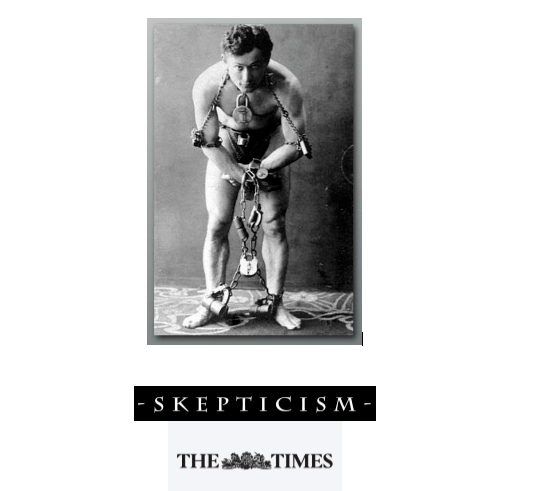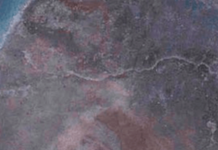In a piece entitled ‘Illusionists must be honest if magic is to survive’ carried by The Times of London on 25 July 2016, one of its leader writers Oliver Kamm paid tribute to conjurers, stage magicians and illusionists such as Houdini. However, Kamm veered into error when turning his article into an attack upon parapsychology, casually stating:
“….magicians are essential agents of rationality. In the low dishonest decade of the 1970s, forsaken by reason as much as good taste, even some scientists took up the cause of testing psychokinesis, telepathy and spoon bending as if they were the result of anything but trickery. James Randi, another great illusionist, set about showing how all of these stunts could be done by subterfuge.”
Why Oliver Kamm (who was born in 1963) should have seen the 1970s as ‘low and dishonest’ is not clear, but the number of errors and refutable assumptions packed into this paragraph are legion, not least that Kamm failed to recognise psi research actually began some 90 years before and continues today.

Not all magicians have been hostile to psi research – for example Michael Bentine (1926-1996).
It is a trite point that over the decades a number of conjurors have taken psychic phenomena very seriously; examples include Michael Bentine (1922-1996) and David Berglas (1926 -). The Oliver Kamm article is in keeping with the skeptic tradition of innuendoes, selective reporting, weak and flimsy accusations, magnification of any type of data that seems supportive and the minimization of positive data, or simply just refusing to face any evidence contradicting the materialist hypothesis for existence. More than anything, his opinion reflected the style of the person he mentions – James Randi. Rather sadly, Oliver Kamm has seemingly been duped himself by the claim that James ‘the Amazing’ Randi (who turns 88 on 7 August) “set about showing how all of these stunts could be done by subterfuge.”
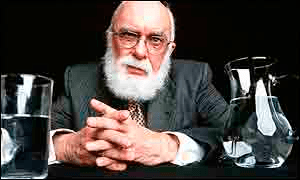
James Randi (1928- ) who has a long career as a magician-skeptic
Except Randi didn’t. Randi may have claimed he could duplicate all reported psi effects, but failed to do so, and his activities cannot be mistaken as scientific research. As regards Kamm’s article, if this is the best that apologists for ‘skepticism’ (as its proponents on both sides of the Atlantic like to spell it) can manage, skepticism as a movement is in a poor state of health.
I have long taken the view that it is wrong to ever exclude critics of psi phenomena from investigation or debate; subjects should advance through argument and evidence, not by the censorship of unpopular or independent views. Indeed, stage magicians and conjurors would be a welcome addition to certain debates and arguments, and there have been some valuable collaborations in the past. However, the significance of conjurors and illusionists in the field needs to be properly understood – and accurately reported.
Evidence for psi effects
The evidence for psi phenomena is very different to what Kamm imagines. Four research areas have accumulated evidence over the last century and have become enormous fields in themselves. Conjuring tricks and deceits fail to provide answers and explanations.

The Rosenheim Poltergeist at work in 1967
These four areas are:
(1) Spontaneous cases, such as those collated since the 1880s through to the 21st century, in many countries. To give four examples of poltergeist cases, Sauchie, Scotland (1960), Rosenheim, Germany (1967-68) Enfield, England (1977-79) and Humpty Doo, Australia (1998) all provide a wealth of evidence of paranormal physical effects. (See also the article on this website on the research of Barrie Colvin on instrumental evidence and poltergeist raps).
(2) Qualitative experiments involving psi powers, from the early days of psychical research such as those of Guthrie, and Miles and Ramsden and published by the Society for Psychical Research, and more recently remote viewing and the Ganzfeld experiments.
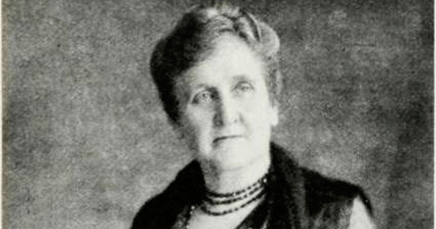
Mrs Piper (1859-1950) a medium who produced extraordinary results
(3) Mediumistic utterances, such as those of Mrs Leonora Piper and others; including the ‘cross-correspondences’ between 1901-1925 and others (sometimes including much material too complex for most skeptics to penetrate).
(4) Quantitative experiments, begun by Sir William Barrett, Edmund Gurney, and Frederic Myers in the 1880s and continuing down to the present day, often involving detailed statistical analysis. Modern examples include the work of Robert Jahn (1980s) and Daryl Bem’s research into presentience effects published in 2011.
With some categories of paranormal phenomena, more than one heading is covered by findings and research, as with the work of Rupert Sheldrake into the sense of being stared at, and with dogs which can sense their owners returning home.
Oliver Kamm either does not know or shuts his eyes to all of this. The only authority he cites is James Randi who became a hero to the less informed end of the skeptical movement and, equally for many on the psychic scene, has filled the role of the ‘man you love to hate’ for many believers. James Randi deserves neither such label, though no-one can doubt his sustained talent for self-promotion spread over decades.
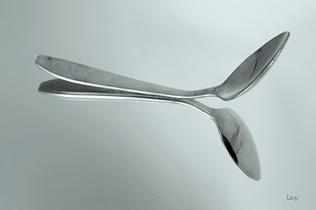
Randi would not have enjoyed his high profile but for his often newsworthy attacks on psychic claimants, and for the tacit, and open encouragement given by his intellectual masters and fellow apologists in skeptic movement.
As demonstrated in Randi’s Prize (2009) by Robert McLuhan, Randi’s approach has been to make blanket accusations that the evidence accumulated by parapsychology is nonsense. However, Randi is weak on details and facts, although his repeated drip-feed claims have the effect of fuelling popular prejudices. Similarly, little faith can be put in Randi’s claims to conduct any meaningful research, nor in his repeated offers of ‘prizes’ for anyone producing positive results under conditions he alone prescribes.
Perhaps one of the most shameful incidents in the UK was in 1975 when he collaborated with the magazine New Scientist to hoax staff at the spiritualist newspaper Psychic News with fake physical phenomena. As the late Stan Gooch put it, if to steal from the house of someone who trusts you is a clever act, then the conspiracy between New Scientist and James Randi to organise this set-up was a clever deed. It may have been the inspiration for a similar stunts at the University of Washington over 1979-81 involving duping researchers, but the reactions to the latter were far from favourable by many professional scientists who were skeptics themselves. Basically, laboratories are not playgrounds for entertainers.
This was all apparent nearly 40 years ago when Randi offered to pay out $1000 for any errors in an article he had written attacking one set of parapsychologists. A sadly short-lived publication Alpha in the UK examined the situation, and in the interests of balance gave James Randi a platform to put his point of view. Alpha nonetheless went on to identify that Randi had made errors and now owed the research institute concerned $1000 if he was to fulfil his promise. But he did not pay up. Mistakes made in some of Randi’s other writings on the experiments by Russell Puthoff and Harold Targ into remote viewing in the 1970s were also highlighted in 1980, and since.
James Randi’s book The Supernatural A-Z: The Truth and the Lies (1995) has largely disappeared from circulation because of its errors. To give an example from the one-page entry on the Borley haunting, the church is not “Borley Abbey” and the claim that Harry Price took up residence in 1937 and arranged for colleagues to live there in shifts is erroneous. Price rented the rectory but did not live in it, and many of the investigators stayed for very short vigils. The rectory was not “reduced to ashes” in 1939, as the ruins remained a site of investigation and excavation, and were much visited until 1944, when they were finally dismantled. Randi claimed Harry Price’s library contains “several volumes dealing with conjuring” – in fact it is one of the largest collections in the world.
Over two decades later James Randi attacked the work of Rupert Sheldrake on dogs which knew their owners were coming home, suggesting a telepathic link. Randi claimed to have conducted experimental studies which refuted this. Sheldrake then asked him to produce the evidence. Randi then claimed that the test results had been lost in floods and storm damage. This shows a confusion over dates at the very least (the storm concerned was Hurricane Wilma which had occurred four years before the alleged trials). One wonders if Mr Randi or anyone else entered an insurance for the loss of the test records?
However, on occasion, certain tests which have been instigated by Rand himself of his own initiative to prove the falsity of psychic claimants have seemingly backfired. These include an occasion in Australia in 1980 when water diviners tested under his basilisk glare turned up positive results when divining for water, but only achieved results expected by chance when searching for gold. James Randi then declared a ‘null’ result by mixing the results of the two tests together and averaging them out.

This was an elementary statistical error pointed out by his friend the late Arthur C. Clarke (See Arthur C. Clarke’s World of Strange Powers (1985)). In 1991 in an entertaining series, James Randi Investigates, broadcast on Britain’s ITV network, Randi tested a map dowser who, on camera, was able to accurately locate a hidden target by simple viewing a blank grid map with odds of 24-1 against finding the correct square. The dowser succeeded. Unfortunately, despite a claim that this would be followed up with further tests they never took place.
A lot less has been heard of Randi with the advance of years, and serious health problems, and the appearance of critical works such as The Honest Liar, a film documentary made in 2013. Randi has also faced personal embarrassment with the revelation that his male partner was convicted of a 25 year-long identity fraud.
Doubtless for the remainder of his life Randi will continue to be championed by Oliver Kamm and others such as Professor Richard Dawkins, who came out in support for Randi when a plea of mitigation for Randi’s convicted spouse was necessary. That Randi’s brand of invective appeals to committed materialists is not surprising; it provides a diversion from the wider search for truth and the assessment of evidence (as well as perhaps distracting a skeptic away from their own doubts).
But relying upon such an authority and source are frankly less a trumpet call for rationality and truth but more the sound of the leper’s bell for any skeptical movement relying upon them. Any movement that has to employ phalanxes of stage magicians and illusionists as its body guards or hit men is hardly adhering to standards expected in scientific research.
Sources: Alpha September/October 1979 special edition (including ‘Do you want to win $10 000?’ by James Randi).
Eisenbud, Jule (1982) Thoughtography in Grattan-Guinness, Ivor. (Ed.) (1982) Psychical Research: A Guide to Its History, Principles and Practices. Wellingborough: The Aquarian Press. Randi claimed he could duplicate these effects but didn’t.
Gooch, Stan (1978) The Paranormal. UK. Wildwood House.
Guthrie, M., and Birchall, J. ‘Record of Experiments in Thought- transference at Liverpool.’ Proc. S.P.R. i, 1883, 263-83.
Guthrie, M. ‘Further Report on Experiments in Thought-transference at Liverpool’. Proc. S.P.R., 3, 1885, 4 [2] 4-5 [2]
Higginbottom, Adam, ‘The Unbelievable Skepticism of James Randi’ New York Times 14 Nov 2014
Miles, C., and Ramsden, H. Experiments in Thought-Transference. Proc. S.P.R., 2i, 1907, 60-93 and 27, 1914, 279-317.
‘New Spoon Bender puts psychic researchers in magic twist’ in New Scientist 31 July 1975.
Prescott, Michael at:
www.skepticalinvestigations.org/Examskeptics/Prescott_Randi.html
Randi, James (1991) James Randi: Psychic Investigator. ITV Series
Sheldrake Rupert, at http://www.sheldrake.org/reactions/james-randi-a-conjurer-attempts-to-debunk-research-on-animals
Storr, Will, ‘James Randi: Debunking The King of the Debunkers’ Daily Telegraph 9 Dec 2014

